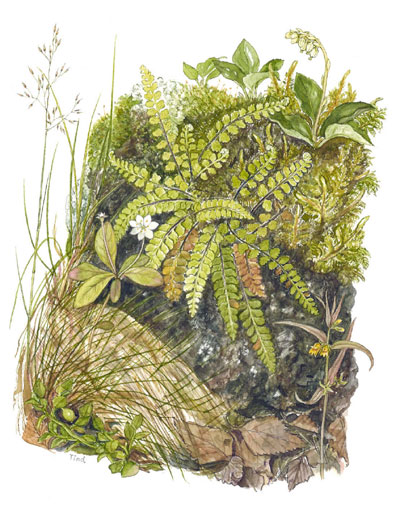|
Hardy Fern Home A. adulterinum resources All Ferns � Aspleniaceae �� Asplenium
�Other Genera
|
| Asplenium adulterinum | ||
Adulterated spleenwort | ||
|
Etymology
Adulterinum, not genuine, or pure.
Description
Rhizome: short-creeping, seldom branching, scales clathrate, black or with narrow pale borders, narrowly lanceolate, to 2 mm.
Frond: 16 cm high by 1.2 cm wide, evergreen, somewhat dimorphic, fertile fronds stiff, erect, sterile prostrate, only to 10 cm, blade/stipe ratio: . Stipe: reddish brown , lustrous, continuing into the rachis, then the last 2 cm of the rachis green, black linear scales at base, vascular bundles: 2 C-shaped, back to back, uniting to 1 upwards in an X-shape. Blade: 1-pinnate, linear, widest above the middle, tapering to either end, thick (open habitat) to herbaceous (shaded, moist habitat), essentially glabrous. Pinnae: 10 to 30 pair, rhombic or ovate, apex rounded to acute, sometimes toothed, subopposite; costae rachis grooved, unwinged (compare to trichomanes); margins crenate or entire; veins free, forked. Sori: linear, 1.5 mm, 1--3 pairs per pinna, paired across the midrib, indusium: white or translucent, thin, entire, often deciduous, on one side of the sorus, sporangia: brown, maturity: midsummer. Culture
Habitat: serpentine and ultrabasic rock crevices, rare everywhere.
Distribution: Norway and Finland, south to France and Greece, highly disjunct (or introduced) on Vancouver Island.
Hardy to -20�C, USDA Zone 6 cited, but the Finnish station argues for greater hardiness.
Distinctive Characteristics
Midway in character between two similar parents, A. trichomanes and A. viride, an obvious differentiating character is the color of the stipe and rachis, lustrous brown the entire length in the former, an entirely green rachis in the latter, and a rachis where the top 2 cm is green in A. adulterinum. The habit is quite erect in A. trichomanes, arching in A. viride, and intermediate, spreading stiffly in A. adulterinum.
|
|
|
